The Sutter Cane School of Disembodied Poetics
In the Mouth of SHOCKTOBER 2023
Everyone claims that writing is difficult, but it must come easier for others than it does for me. How else to explain the ease with which they pump out pieces every week, or every two weeks, or on any kind of fixed schedule at all? Thankfully, every so often, I too can rise above the gobbledegook and deliver.
I’m getting better at starting posts; it’s the follow-through that’s been giving me trouble. But I’ve managed a fast pace before with my SHOCKTOBER series. My wife and I have spent the last few Octobers watching horror films together, and last year, I covered them here, even managing a post a week. Though I’ve obviously failed to replicate that pace this year – I blame my issues with follow-through – we’ve kept up the tradition. That is, we’ve been watching.
In the spirit of the season (and follow-through), here’s a quick write-up of the horror and horror-adjacent films we’ve watched this month, along with several more I watched on my own. Happy Halloween!
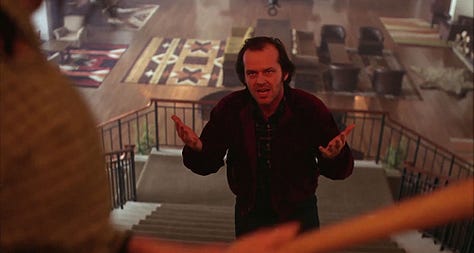
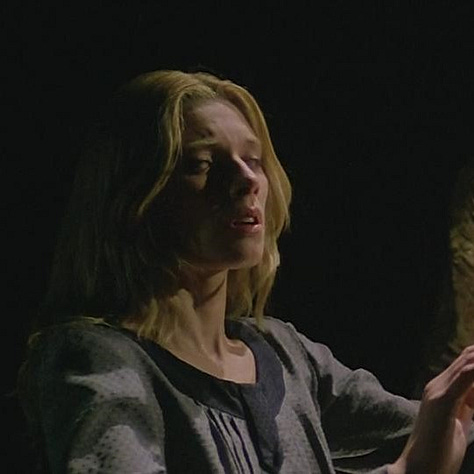
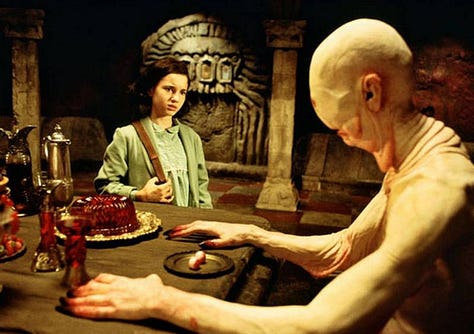

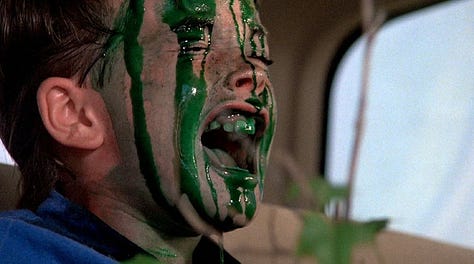


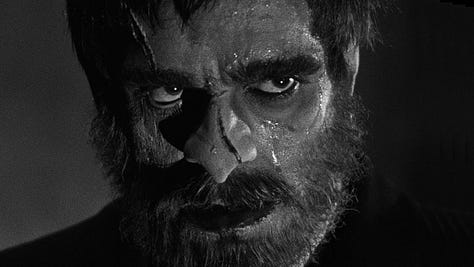

We kicked off SHOCKTOBER ‘23 with a screening of Stanley Kubrick’s The Shining (1980) at Alamo Drafthouse – in other words, with a bang. I’ve probably seen The Shining a dozen times, but the theater experience was new, and it helped remind me just why I love this film so much. What could I say about it that hasn’t already been said, that really captures its intricate, mysterious, haunting appeal? It’s sublime. It’s the greatest horror movie ever made. It’s one of the best movies ever made. If you haven’t seen it, see it. And if you’ve seen it, see it again.
Given my love for The Shining, maybe it was inevitable that I’d be disappointed by Doctor Sleep (2019) – a sequel that would have worked better as a standalone film. In contrast to the novel, which is at its best when it draws directly on The Shining (the novel), Doctor Sleep the film only works at a remove from its predecessor The Shining (the film). King’s Shining and Kubrick’s are oil and water – try to mix them, as this film does, and you’ll end up with undrinkable scum. Or, to put it another way, the two Shinings are apples and oranges, “both delicious, but very different.”
Much like The Shining, The Beyond (1981), “Godfather of Gore” Lucio Fulci’s shocking contribution to the haunted hotel subgenre, cultivates a series of unforgettable nightmare images. But where Kubrick strives for absolute control, Fulci thrives in chaos. An absolutely insane parade of beatings, impalements, crucifixions, waterlogged corpses, faces dissolved in acid, torn throats, vicious dog attacks, man-eating tarantulas, gruesome apparitions, hordes of zombies, and so, so many gouged eyeballs, The Beyond is a symphony of mud and viscera, slime and gore, shock and terror. This is a twisted, evil movie, and I loved it. There’s little else I can think to say – it’s all up there on the screen.
There are two worlds in Guillermo Del Toro’s dark fantasy Pan’s Labyrinth (2006), and the film draws parallels between them with great elegance and subtlety. The threats posed by the fantastical world of fauns, fairies, mandrakes, and magic discovered by 11-year-old Ofelia (Ivana Baquero) pale in comparison to those posed by her mother’s vicious new husband (Sergi López), a Captain in the military of Francoist Spain. There’s a very real sense in which the true monster of Pan’s Labyrinth is fascism, the brutality of the patriarchal militarized state. What I’d forgotten, though, was the ambiguity of the ending – specifically, the question of whether magic and imagination have the power to transcend that brutality. Immediately after our viewing, I felt sure that Pan’s Labyrinth comes down firmly on the side of magic. Now, with hindsight, I’m not so sure.
“A ghost in the house brings good luck,” says Choi Yeon-gyo (Cho Yeo-jeong) in Parasite (2019), and while she’s just repeating an old Korean wives’ tale, her words prove prophetic. Though not strictly a horror film, writer-director Bong Joon-ho brings a distinct horror sensibility to this story of a poor family, the Kims, who con their way into working for the wealthy Parks – and dispose of some competing workers in the process. A world where the have-nots are willing to tear each other to shreds for a chance to suckle at the teat of the haves – imagine that! Parasite is an exercise in making every second – and every ghost – matter, and that gives it far more power than a thousand common monster movies.
Not that there’s anything wrong with monster movies, of course, especially those that follow Frank Zappa’s axiom of “Cheepnis” – “The cheaper they are, the better they are.” And there’s no film that better exemplifies this spirit than the cult classic Troll 2 (1990), in which the vacationing Waits family does battle with a town of evil goblins (which, one might note, are not the same as trolls). This film is not so much “so bad it’s good” as “so bad it’s perfect” – everything in it, from the nonsensical script to the bizarre acting to the dirt-cheap special effects to the porny late-’80s soundtrack, is wrong, and in just the right way. I wouldn’t change a frame.
We made time for some classic monsters too, of course. The chilling silent classic Nosferatu (1922) is up to its cold, dead eyes in atmosphere, and Count Orlock remains no less frightening now than he was a century ago. This one’s legendary for a reason, folks – as is the Universal Studios horror classic The Wolf Man (1941), starring Lon Chaney, Jr. Chaney’s first transformation into the title character is the most satisfying moment in the world, to the point where it nearly eclipses the rest of the movie. But it’s the ending of The Wolf Man that hits hardest. Effective horror films are often tragedies at heart, and this one carries real emotional weight.
Speaking of Universal horror, I followed up last year’s viewing of The Bride of Frankenstein (1935) with a double helping of director James Whale. The Invisible Man (1933) is a darkly comic morality tale, with a strong central performance from Claude Rains and some clever, inventive special effects. But I liked the earlier Whale effort The Old Dark House (1932) even more. It’s all about the ending with this one – when Boris Karloff’s hulking Morgan carries Saul (Brember Wills) upstairs, he does so with such incredible tenderness it’s almost unbearable. It’s a reminder that Whale’s greatest strength is his sense of pathos – that is, his empathy for outcasts and so-called monsters.
Voodoo horror is due for a reappraisal, I think. Part folk horror and part zombie film, with an obvious racial subtext rich for exploration, this often-forgotten subgenre could easily form the basis of a new masterpiece in the hands of Jordan Peele or Ari Aster. Horror legend Wes Craven’s contribution to voodoo horror, The Serpent and the Rainbow (1988), is a worthwhile one, particularly its harrowing second half, and though Bill Pullman feels somewhat out of place as a Harvard anthropologist investigating Haitian zombies, the supporting cast – Cathy Tyson, Zakes Mokae, Paul Winfield, Brent Jennings, and Conrad Roberts – gives Serpent enough character for that not to matter. Craven was a man who knew how to make do with what he had, as well as how to play to his strengths. Naturally, the best parts are the dream sequences.
I have to close with what for me was a major new discovery – John Carpenter’s In the Mouth of Madness (1994). Sam Neill plays John Trent, an insurance adjuster investigating the disappearance of blockbuster horror writer Sutter Cane (a chillingly enigmatic Jürgen Prochnow), whose Lovecraftian novels outsell Stephen King’s – and may or may not drive their readers murderously insane. This film is a strange, unique object, somehow able to synthesize Lovecraftian mythos, Cronenbergian body horror, and the pulpy aesthetic of dimestore horror paperbacks into a compelling tale of creeping dread. It takes root in your brain like a tumor. I’m dying to see it again.
Tonight, though, we’ll be settling in to watch A Nightmare on Elm Street 3: Dream Warriors (1987). We’re both fans of the first film – the second, not so much – and I’ve heard good things about this one. Either way, there’s no horror icon we trust more to close out our SHOCKTOBER than Freddy Kreuger. It’s good, three years in, to have some mainstays we can count on.
For a while, I considered some tweaks to the SHOCKTOBER format, including capsule reviews of great horror films I watched after the end of last October. Obviously I never wrote the reviews, but I did make a list of the films, so – here you go. Enjoy. And remember to read Sutter Cane.
Rabid (1977)
The Hills Have Eyes (1977)
Dead & Buried (1982)
Nightbreed (1990)
Train to Busan (2016)
Barbarian (2022)


